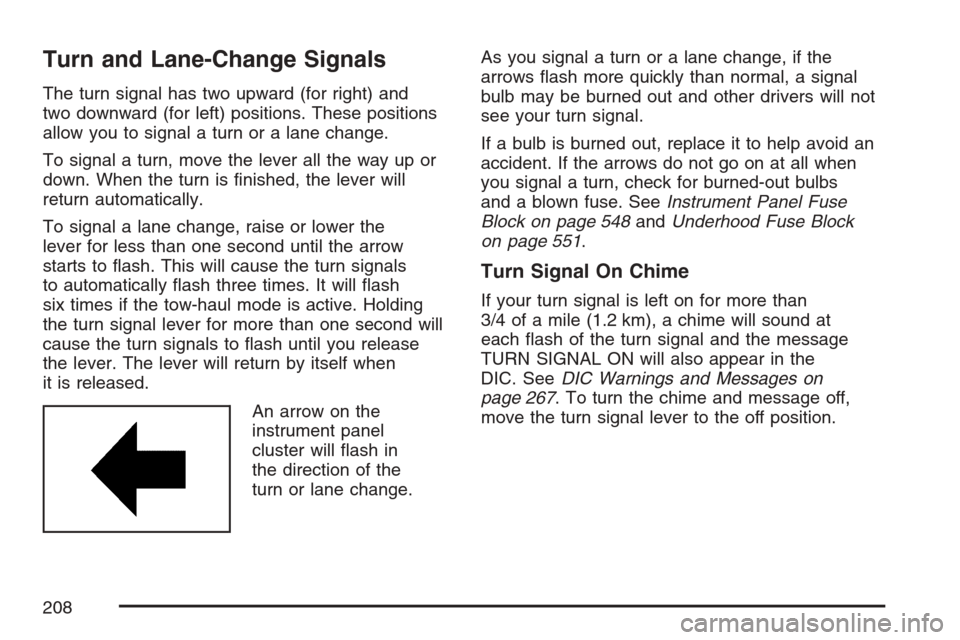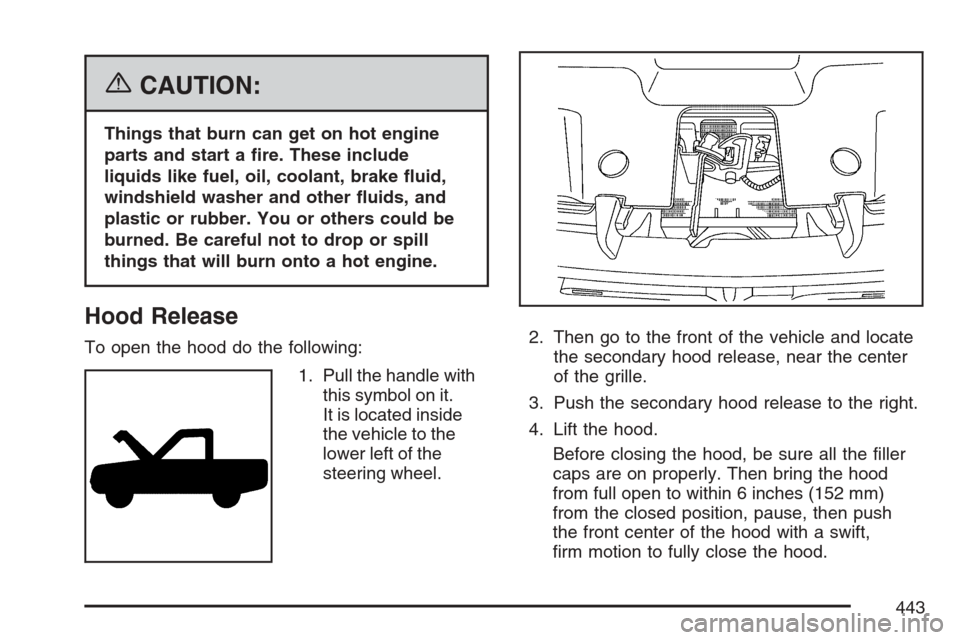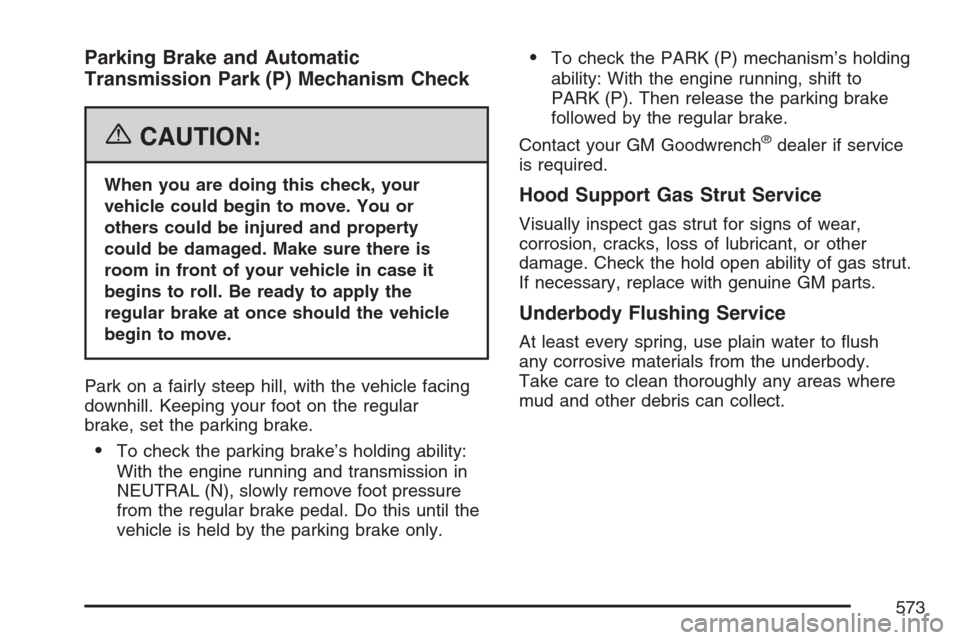2007 CHEVROLET AVALANCHE hood release
[x] Cancel search: hood releasePage 208 of 618

Turn and Lane-Change Signals
The turn signal has two upward (for right) and
two downward (for left) positions. These positions
allow you to signal a turn or a lane change.
To signal a turn, move the lever all the way up or
down. When the turn is �nished, the lever will
return automatically.
To signal a lane change, raise or lower the
lever for less than one second until the arrow
starts to �ash. This will cause the turn signals
to automatically �ash three times. It will �ash
six times if the tow-haul mode is active. Holding
the turn signal lever for more than one second will
cause the turn signals to �ash until you release
the lever. The lever will return by itself when
it is released.
An arrow on the
instrument panel
cluster will �ash in
the direction of the
turn or lane change.As you signal a turn or a lane change, if the
arrows �ash more quickly than normal, a signal
bulb may be burned out and other drivers will not
see your turn signal.
If a bulb is burned out, replace it to help avoid an
accident. If the arrows do not go on at all when
you signal a turn, check for burned-out bulbs
and a blown fuse. SeeInstrument Panel Fuse
Block on page 548andUnderhood Fuse Block
on page 551.
Turn Signal On Chime
If your turn signal is left on for more than
3/4 of a mile (1.2 km), a chime will sound at
each �ash of the turn signal and the message
TURN SIGNAL ON will also appear in the
DIC. SeeDIC Warnings and Messages on
page 267. To turn the chime and message off,
move the turn signal lever to the off position.
208
Page 380 of 618

Q:Am I likely to stall when going downhill?
A:It is much more likely to happen going
uphill. But if it happens going downhill,
here is what to do.
1. Stop your vehicle by applying the regular
brakes. Apply the parking brake.
2. Shift to PARK (P) and, while still braking,
restart the engine.
3. Shift back to a low gear, release the parking
brake, and drive straight down.
4. If the engine will not start, get out and
get help.
Driving Across an Incline
Sooner or later, an off-road trail will probably
go across the incline of a hill. If this happens,
you have to decide whether to try to drive across
the incline. Here are some things to consider:
A hill that can be driven straight up or down
may be too steep to drive across. When you go
straight up or down a hill, the length of the
wheel base — the distance from the front
wheels to the rear wheels — reduces the
likelihood the vehicle will tumble end over end.
But when you drive across an incline, the much
more narrow track width — the distance
between the left and right wheels — may not
prevent the vehicle from tilting and rolling over.
Also, driving across an incline puts more weight
on the downhill wheels. This could cause a
downhill slide or a rollover.
Surface conditions can be a problem when
you drive across a hill. Loose gravel, muddy
spots, or even wet grass can cause the tires
to slip sideways, downhill. If the vehicle slips
sideways, it can hit something that will
trip it — a rock, a rut, etc. — and roll over.
380
Page 429 of 618

Service........................................................ 432
Accessories and Modi�cations................... 433
California Proposition 65 Warning.............. 433
Doing Your Own Service Work.................. 434
Adding Equipment to the Outside
of Your Vehicle...................................... 435
Fuel............................................................. 435
Gasoline Octane........................................ 436
Gasoline Speci�cations.............................. 436
California Fuel........................................... 436
Additives................................................... 437
Fuel E85 (85% Ethanol)............................ 438
Fuels in Foreign Countries........................ 439
Filling the Tank......................................... 440
Filling a Portable Fuel Container............... 442
Checking Things Under the Hood.............. 442
Hood Release........................................... 443
Engine Compartment Overview.................. 444
Engine Oil................................................. 446
Engine Oil Life System.............................. 449Engine Air Cleaner/Filter............................ 451
Automatic Transmission Fluid.................... 454
Engine Coolant.......................................... 457
Coolant Surge Tank Pressure Cap............ 460
Engine Overheating................................... 460
Overheated Engine Protection
Operating Mode..................................... 463
Cooling System......................................... 464
Engine Fan Noise..................................... 469
Power Steering Fluid ................................. 469
Windshield Washer Fluid........................... 470
Brakes...................................................... 472
Battery...................................................... 475
Jump Starting............................................ 476
Rear Axle.................................................... 482
Four-Wheel Drive........................................ 483
Front Axle................................................... 484
Headlamp Aiming........................................ 485
Section 5 Service and Appearance Care
429
Page 443 of 618

{CAUTION:
Things that burn can get on hot engine
parts and start a �re. These include
liquids like fuel, oil, coolant, brake �uid,
windshield washer and other �uids, and
plastic or rubber. You or others could be
burned. Be careful not to drop or spill
things that will burn onto a hot engine.
Hood Release
To open the hood do the following:
1. Pull the handle with
this symbol on it.
It is located inside
the vehicle to the
lower left of the
steering wheel.2. Then go to the front of the vehicle and locate
the secondary hood release, near the center
of the grille.
3. Push the secondary hood release to the right.
4. Lift the hood.
Before closing the hood, be sure all the �ller
caps are on properly. Then bring the hood
from full open to within 6 inches (152 mm)
from the closed position, pause, then push
the front center of the hood with a swift,
�rm motion to fully close the hood.
443
Page 486 of 618

To adjust the vertical aim, do the following:
1. Open the hood. SeeHood Release on
page 443for more information.
2. Locate the aim dot on the lens of the
low-beam headlamp.
3. Measure the distance from the ground to the
aim dot on the low-beam headlamp. Record
the distance.4. At the wall or other �at surface, measure from
the ground upward (A) to the recorded
distance from Step 3 and mark it.
5. Draw or tape a horizontal line (B) on the wall
or �at surface the width of the vehicle at the
height of the mark in Step 4.
Notice:Do not cover a headlamp to improve
beam cut-off when aiming. Covering a
headlamp may cause excessive heat build-up
which may cause damage to the headlamp.
486
Page 569 of 618

(f)Lubricate all key lock cylinders, hood latch
assembly, secondary latch, pivots, spring anchor,
release pawl, midgate hinges, side storage
box door hinges, tailgate hinges, tailgate linkage,
outer tailgate handle pivot points, latch bolt,
fuel door hinge, locks, and folding seat hardware.
More frequent lubrication may be required
when exposed to a corrosive environment.
Applying silicone grease on weatherstrips with a
clean cloth will make them last longer, seal better,
and not stick or squeak.
(g)Check vent hose at transfer case for kinks and
proper installation.
(h)Change automatic transmission �uid and �lter
if the vehicle is mainly driven under one or
more of these conditions:
�In heavy city traffic where the outside
temperature regularly reaches 90°F (32°C)
or higher.
�In hilly or mountainous terrain.
�When doing frequent trailer towing.
�Uses such as found in taxi, police, or
delivery service.(i)Drain, �ush, and re�ll cooling system. This
service can be complex; you should have
your dealer perform this service. See Engine
Coolant on page 457 for what to use. Inspect
hoses. Clean radiator, condenser, pressure cap,
and �ller neck. Pressure test the cooling
system and pressure cap.
(j)A �uid loss in any vehicle system could indicate
a problem. Have the system inspected and
repaired and the �uid level checked. Add �uid if
needed.
(k)Inspect system. Check all fuel and vapor lines
and hoses for proper hook-up, routing, and
condition. Check that the purge valve works
properly, if equipped. Replace as needed.
(l)If you drive regularly under dusty conditions,
inspect the �lter at each engine oil change.
(m)Visually inspect belt for fraying, excessive
cracks, or obvious damage. Replace belt if
necessary.
569
Page 573 of 618

Parking Brake and Automatic
Transmission Park (P) Mechanism Check
{CAUTION:
When you are doing this check, your
vehicle could begin to move. You or
others could be injured and property
could be damaged. Make sure there is
room in front of your vehicle in case it
begins to roll. Be ready to apply the
regular brake at once should the vehicle
begin to move.
Park on a fairly steep hill, with the vehicle facing
downhill. Keeping your foot on the regular
brake, set the parking brake.
To check the parking brake’s holding ability:
With the engine running and transmission in
NEUTRAL (N), slowly remove foot pressure
from the regular brake pedal. Do this until the
vehicle is held by the parking brake only.
To check the PARK (P) mechanism’s holding
ability: With the engine running, shift to
PARK (P). Then release the parking brake
followed by the regular brake.
Contact your GM Goodwrench
®dealer if service
is required.
Hood Support Gas Strut Service
Visually inspect gas strut for signs of wear,
corrosion, cracks, loss of lubricant, or other
damage. Check the hold open ability of gas strut.
If necessary, replace with genuine GM parts.
Underbody Flushing Service
At least every spring, use plain water to �ush
any corrosive materials from the underbody.
Take care to clean thoroughly any areas where
mud and other debris can collect.
573
Page 609 of 618

H
Hazard Warning Flashers............................ 206
Head Restraints............................................ 18
Headlamp
Aiming..................................................... 485
Headlamps
Automatic Headlamp System.................... 217
Bulb Replacement.................................... 488
Daytime Running Lamps.......................... 216
Flash-to-Pass........................................... 209
Halogen Bulbs......................................... 488
High/Low Beam Changer......................... 209
On Reminder........................................... 216
Heated Seats................................................ 12
Heater......................................................... 227
Heater......................................................... 230
Highbeam On Light..................................... 256
Highway Hypnosis....................................... 393
Hill and Mountain Roads............................. 394
Hood
Checking Things Under............................ 442
Release................................................... 443
Horn............................................................ 206
How to Use This Manual................................ 4
How to Wear Safety Belts Properly............... 26
I
Ignition Positions......................................... 123
Infants and Young Children,
Restraints.................................................. 48
In�ation - Tire Pressure............................... 500
Instrument Panel
Overview.................................................. 204
Instrument Panel (I/P)
Brightness................................................ 219
Cluster..................................................... 240
J
Jump Starting.............................................. 476
K
Keyless Entry System................................... 94
Keys............................................................. 93
609